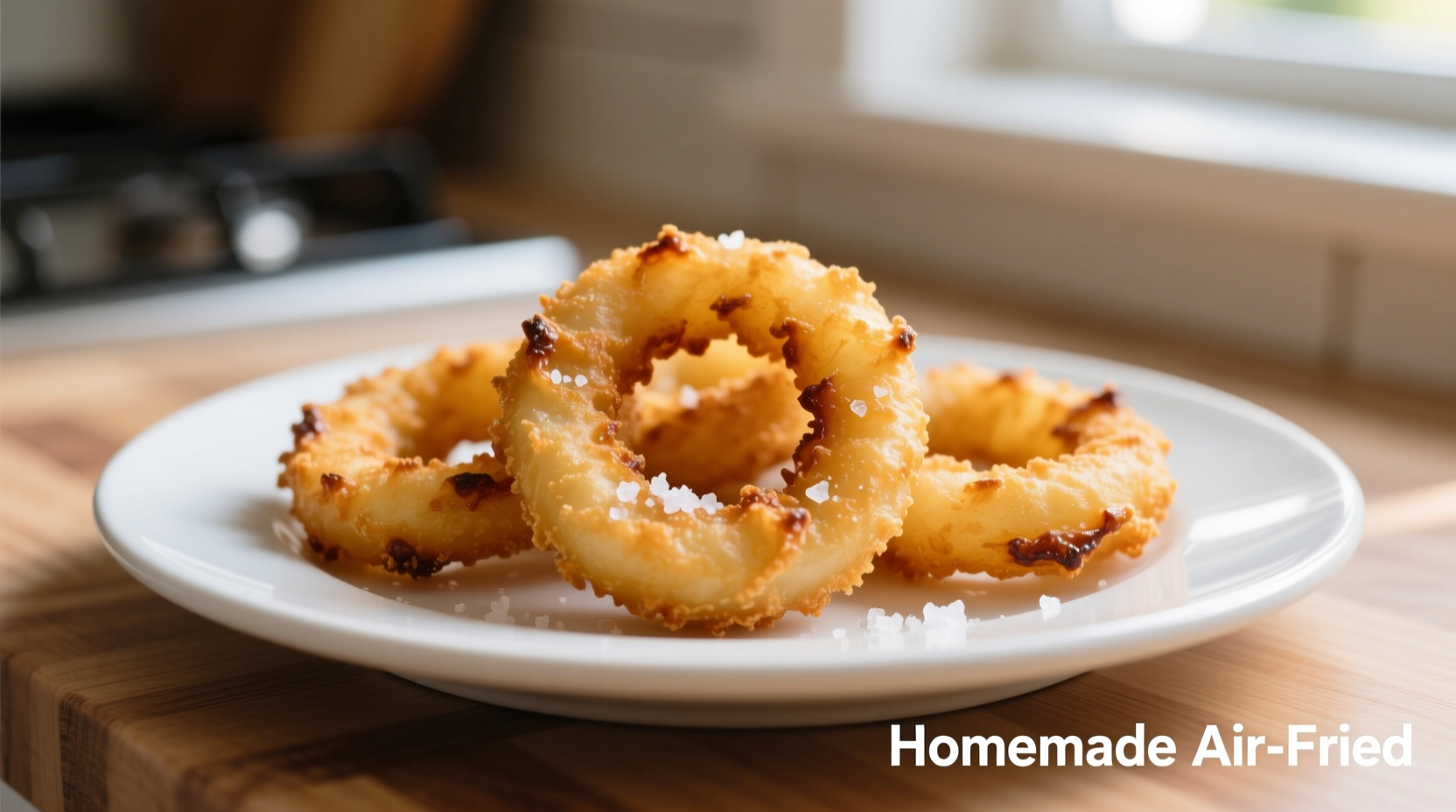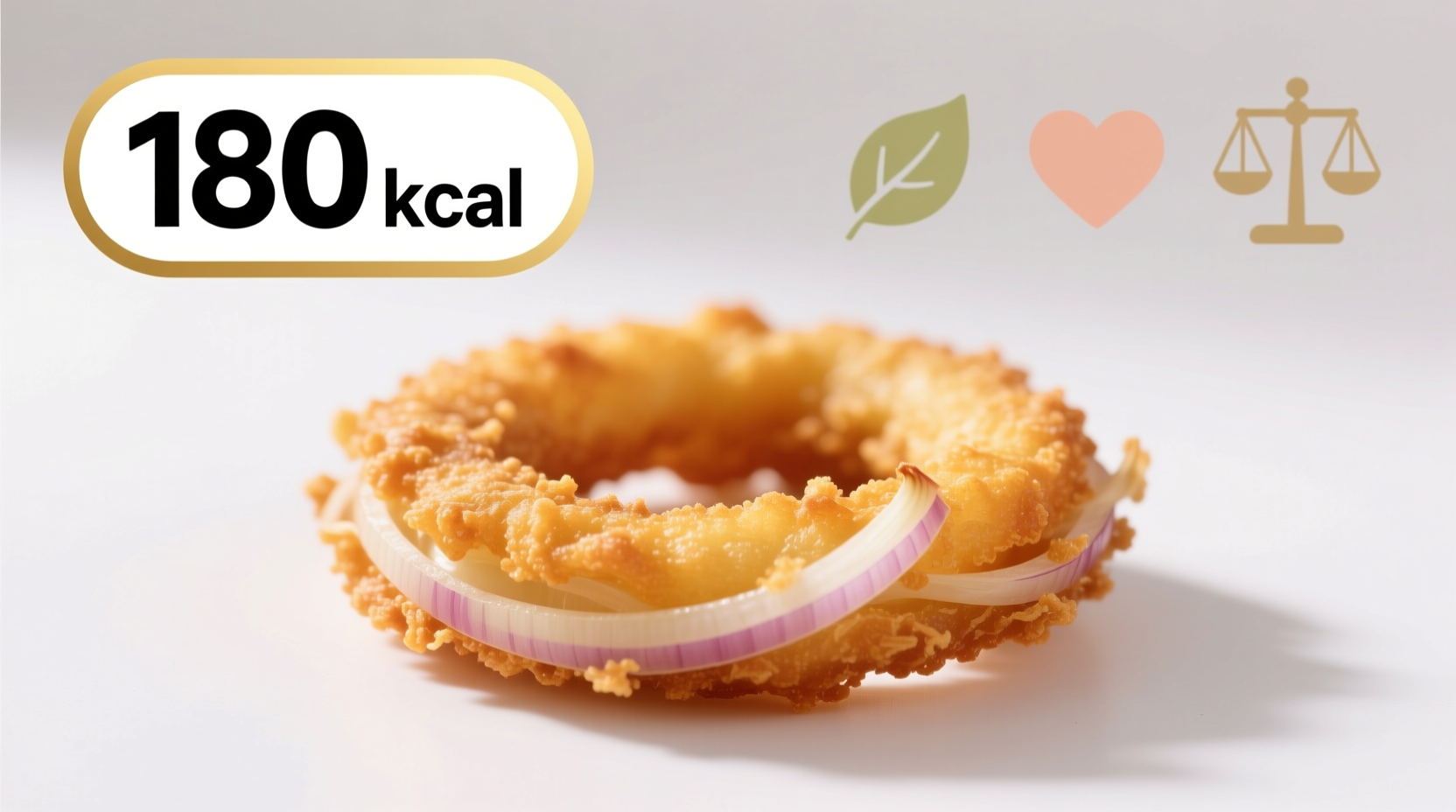Why Calorie Counts Vary So Much in Onion Rings
Understanding onion ring calories requires examining three key factors: batter composition, oil absorption during cooking, and portion size. Most commercial onion rings derive 65-75% of their calories from fat (primarily absorbed cooking oil), 20-25% from carbohydrates (batter and breading), and only 5-10% from the onion itself.
Deep-Fried vs. Air-Fried: Calorie Comparison
The cooking method dramatically impacts final calorie content. Traditional deep-frying submerges rings in 350-375°F oil, causing significant oil absorption—typically 15-25% of the finished product's weight. Air-frying uses rapid convection to create crispiness with minimal oil, reducing total fat content substantially.
| Cooking Method | Calories (per 100g) | Total Fat (g) | Carbs (g) |
|---|---|---|---|
| Traditional Deep-Fried | 380-420 | 20-24g | 40-45g |
| Lightly Breaded Deep-Fried | 320-360 | 16-19g | 35-40g |
| Air-Fried (minimal oil) | 220-260 | 8-12g | 35-40g |
| Baked (oil spray) | 240-280 | 10-14g | 35-40g |
This nutritional comparison, based on USDA FoodData Central measurements, shows how cooking technique directly impacts calorie density. The batter-to-onion ratio significantly affects final values—thicker batters absorb more oil during frying.
Restaurant Chain Calorie Breakdown
Popular restaurant chains show considerable variation in onion ring nutrition profiles. These values reflect standard side portions:
| Restaurant | Portion Size | Calories | Fat (g) |
|---|---|---|---|
| McDonald's | 3.2 oz (90g) | 390 | 21g |
| Burger King | 3.5 oz (100g) | 420 | 24g |
| Wendy's | 4.0 oz (113g) | 460 | 25g |
| Chick-fil-A | 3.0 oz (85g) | 350 | 19g |
| Homemade (standard recipe) | 3.5 oz (100g) | 380 | 22g |
Data sourced from official restaurant nutrition guides (2024) reveals that portion size differences account for much of the calorie variation between chains. Wendy's larger portion explains its higher total calories despite similar density to competitors. These values reflect standard preparation methods using vegetable oil for deep-frying.
Nutritional Context: Where Onion Rings Fit
For adults following a 2,000-calorie diet, a standard serving of onion rings represents 18-21% of daily calories and 30-38% of recommended fat intake. However, they do provide some nutritional benefits:
- Fiber content: 2-3g per serving (8-12% of daily needs)
- Vitamin C: 8-10mg (10-13% of daily value from onions)
- Quercetin: Antioxidant compound naturally present in onions
Compared to other common snack foods, onion rings fall between french fries (higher in fat) and vegetable sticks with dip (lower in calories but often high in sodium). The key nutritional limitation is their low protein content (typically 3-5g per serving), which reduces satiety compared to protein-rich snacks.

Practical Strategies for Lower-Calorie Onion Rings
As a chef who's worked with both restaurant kitchens and home cooks, I've developed these evidence-based techniques to reduce calories without sacrificing texture:
Ingredient Modifications
- Thinner batter: Use a 1:1 flour-to-milk ratio instead of traditional thick batters (reduces calories by 40-60 per serving)
- Alternative flours: Substitute 25% of wheat flour with chickpea flour for added protein and reduced browning
- Oil selection: When air-frying, use avocado oil spray (monounsaturated fats) instead of vegetable oil
Cooking Technique Adjustments
- Chill onion rings for 15 minutes before cooking to reduce oil absorption
- Maintain consistent oil temperature (365°F) to prevent excessive oil uptake
- Use a wire rack instead of paper towels after cooking to drain excess oil
- For air-frying, flip halfway through cooking to ensure even crispness with minimal oil
Portion Control Tactics
Research from the American Journal of Clinical Nutrition shows that visual cues significantly impact consumption. Try these approaches:
- Serve on a smaller plate to create visual abundance
- Mix with roasted vegetables for increased volume with fewer calories
- Use a 3:1 ratio of vegetables to onion rings in snack platters
Common Questions About Onion Ring Calories
How many calories in 5 onion rings?
Five medium onion rings typically contain 175-210 calories when deep-fried. The exact count depends on size and preparation method—air-fried versions would contain approximately 110-130 calories for the same quantity.
Are onion rings healthier than french fries?
Neither is significantly healthier, but they differ nutritionally. Onion rings typically contain 10-15% more calories than equivalent portions of french fries due to batter and oil absorption. However, they provide slightly more fiber and vitamin C from the onion itself. Both are best enjoyed in moderation as occasional treats rather than regular dietary components.
Do onion rings have more calories than the onion itself?
Yes, significantly. A single medium onion contains about 60 calories, while 10 fried onion rings made from that same onion contain 350-420 calories. The additional calories come primarily from absorbed cooking oil (60-70% of extra calories) and the batter (30-40%). The frying process transforms a low-calorie vegetable into a calorie-dense food product.
Can I make truly low-calorie onion rings at home?
Air-fried onion rings with minimal oil spray can reduce calories to 220-260 per 100g serving—about 35% lower than traditional deep-fried versions. Using a light tempura-style batter instead of thick breading further reduces calories while maintaining crisp texture. For the lowest calorie option, try oven-baked rings with a cornflake coating that requires minimal oil spray.











 浙公网安备
33010002000092号
浙公网安备
33010002000092号 浙B2-20120091-4
浙B2-20120091-4